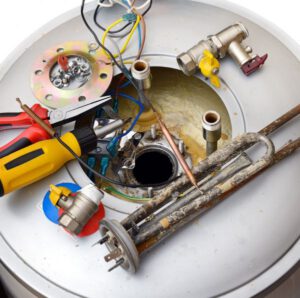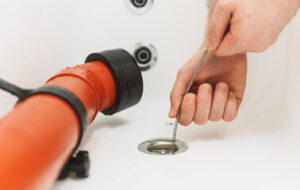Residential plumbing covers all pipes and fixtures that deliver fresh water to your home and drain wastewater away—understanding how these systems work can help you recognize problems and seek professional assistance when necessary.
Tidal Plumbing & Heating starts with a main water supply line that delivers clean, fresh water to fixtures throughout the house. This includes toilets, faucets, showers, and appliances like washing machines and dishwashers.

The plumbing system in a home is what brings fresh water in and disposes of wastewater. It is what keeps our bathrooms, kitchens, and laundry rooms functional. Residential plumbing includes everything from piping to fixtures, and it can be complex depending on the setup of a home.
The first step in installing a residential plumbing system is laying pipes. This is done during what is known as the rough-in plumbing phase, which typically takes place before the concrete foundation of a house is poured. The rough-in plumbing also involves setting the sewer accommodation stubs, which connect the home’s plumbing to the municipal sewer line.
Once the piping is in place, the fixtures can be installed. This may include anything from bathtubs to toilets, sinks and faucets. It can also include appliances like washing machines, refrigerators and dishwashers, as well as heating and cooling systems.
After the installations are completed, the piping must be connected to the sewer system through what is called the main stack. The main stack is what carries the drain and vent pipes throughout the house. The drain and vent pipes must also be properly vented to keep air flowing freely through the plumbing system.
Another important part of residential plumbing is the installation of a water treatment system. These can be inline treatments that attach directly to the piping or undersink units that are attached underneath sinks. Both of these are designed to remove toxins and other contaminants from the drinking water in a home.
Residential plumbing systems also involve septic systems and sewer lines. This is particularly true for new homes, which require a septic tank to be installed, as well as lines that connect the septic system with the home’s sewage pipe. Older homes might have septic systems already in place, but this can still be a part of residential plumbing services as well.
Commercial buildings require more extensive plumbing setups than residences. This is because they have more occupants and use the plumbing system much more often. This can lead to increased wear and tear on the pipes and fixtures. It can also result in more routine maintenance and emergency repairs. Fortunately, there are experts in commercial plumbing who can help keep your business’s systems running smoothly.
Residential plumbing involves the pipes, fixtures and appliances that supply fresh water to a home and get rid of waste. These systems are complicated networks that include hot & cold water supply pipes, drain lines, traps, valves, venting, and a water storage tank. Most of this infrastructure is buried underground, including water service lines that connect your home to the city water supply and sewer pipes that carry away waste.
A residential plumbing system needs to be in good working order for safe, reliable operation. Any issues with the pipes or fixtures should be fixed as soon as possible to avoid serious damage and expensive repairs. Some common problems include clogged or leaky drains, leaking toilets, and water pressure issues.
When it comes to residential plumbing repair, experienced plumbers can diagnose and fix a wide range of issues. For example, if you have a leaking faucet or clogged drain, a plumber can use specialized tools to remove the blockage and restore proper function. They can also replace older pipes with newer, more durable materials like PEX, ABS or copper.
In addition to fixing common household issues, a plumber can also inspect and repair your water heater. They can identify issues with the water heater’s gas connection, such as a loose or worn out connector, and replace or repair it. They can also check your home’s water heater for signs of rust or corrosion and perform backflow testing to ensure that the water is clean and safe to drink.
While most plumbing problems are solvable with repair work, sometimes you may need to replace an entire component. For example, if you have old, corroded or cracked pipes, replacing them with newer, more durable pipes can prevent future problems and save you money in the long run.
For those who live in rent-controlled apartments, you can ask your landlord to make residential plumbing repairs by filing a petition with Homes and Community Renewal or filing an HP Action in Housing Court to compel them to do so. You can also withhold your rent until the repairs are made if your landlord refuses to do so, but be aware that this could result in an eviction lawsuit.
Residential plumbing systems serve two primary functions: supplying clean water to household appliances and fixtures and draining waste. Leaks and other problems can lead to significant damage if left unchecked, so it is important to address them as soon as you notice them. Some of the most common residential plumbing services include replacing and repairing water heaters, installing toilets, showers, and sinks, and rerouting pipes. A qualified plumber can help you choose and install the best new equipment for your home.
In addition to routine maintenance, there are some instances in which you will need to replace your plumbing altogether. The lifespan of your pipes depends on the materials used and how well they have been maintained. For example, galvanized steel pipes (typically seen in older homes) have a lifespan of about 50 years and are prone to corrosion that can lead to leaks. Copper pipes have a lifespan of about 70 years, and cross-linked polyethylene (PEX) pipes have a lifespan of up to 40-50 years.
Replacing your pipes can be done through a trenchless method that minimizes disruption to your lawn and landscaping. A qualified plumbing company will use a camera to assess the situation and determine the best route for your replacement pipe. They will then remove the old pipe and install a new one, using the existing line as a guide. In most cases, this is completed in just a few hours and doesn’t require digging up your entire yard.
Commercial plumbing is a bit more complicated than residential plumbing, and it requires the service of a qualified professional. Commercial buildings typically have more occupants than residential homes, which means more people using sinks, showers, and toilets. This often results in higher water usage and more frequent plumbing emergencies and routine maintenance needs. Commercial plumbing also requires a larger pipe size than residential plumbing to accommodate more water demands.
If you own a commercial building, it’s a good idea to schedule regular plumbing maintenance to prevent costly repairs and replacements. The professionals at can perform a thorough inspection of your plumbing system to identify any issues before they become major problems.
The plumbing system in a house includes pipes, fixtures, faucets, and appliances that cater to daily living needs. It provides water for drinking, cooking, and washing and gets rid of waste through drainage systems. Plumbing fixtures may be simple or elaborate, depending on the structure’s design and the homeowner’s needs. A residential plumbing system usually links to city-managed water supply lines, while wastewater is directed to a municipal sewer system or septic tank.
A household’s plumbing system requires routine maintenance to keep it functioning properly. A plumber can help with the maintenance by inspecting the entire plumbing system to identify any issues and provide solutions. The plumber can also make sure that the home’s pipes are safe and free from damage.
One of the most common residential plumbing services is installing and repairing water heaters. Since these devices are essential for supplying hot water, it’s important to have them working properly. A plumber can also perform drain cleaning and clog removal to ensure that the water is flowing freely throughout the house.
Another service that a plumber can offer is rerouting pipes. This is particularly useful for older homes that may have outdated plumbing systems. Plumbers can reroute the old pipes to improve the home’s water flow and prevent future problems.
Commercial buildings require more complex plumbing setups than residential ones. This is because they typically have more bathrooms and kitchens than homes, which means that there is higher water usage. This increased usage could lead to more frequent repairs and breakdowns.
Commercial plumbing also involves a wider range of appliances and fixtures than residential ones. For example, a restaurant might need ice machines and dishwashers, which require more complex setups than basic sinks and toilets. Moreover, the plumbing system in a commercial building must be capable of handling a larger number of people at once. This can lead to more wear and tear on the plumbing system, which will require it to be made of sturdier materials. As a result, it’s best to hire a plumbing company with experience in both residential and commercial settings.


